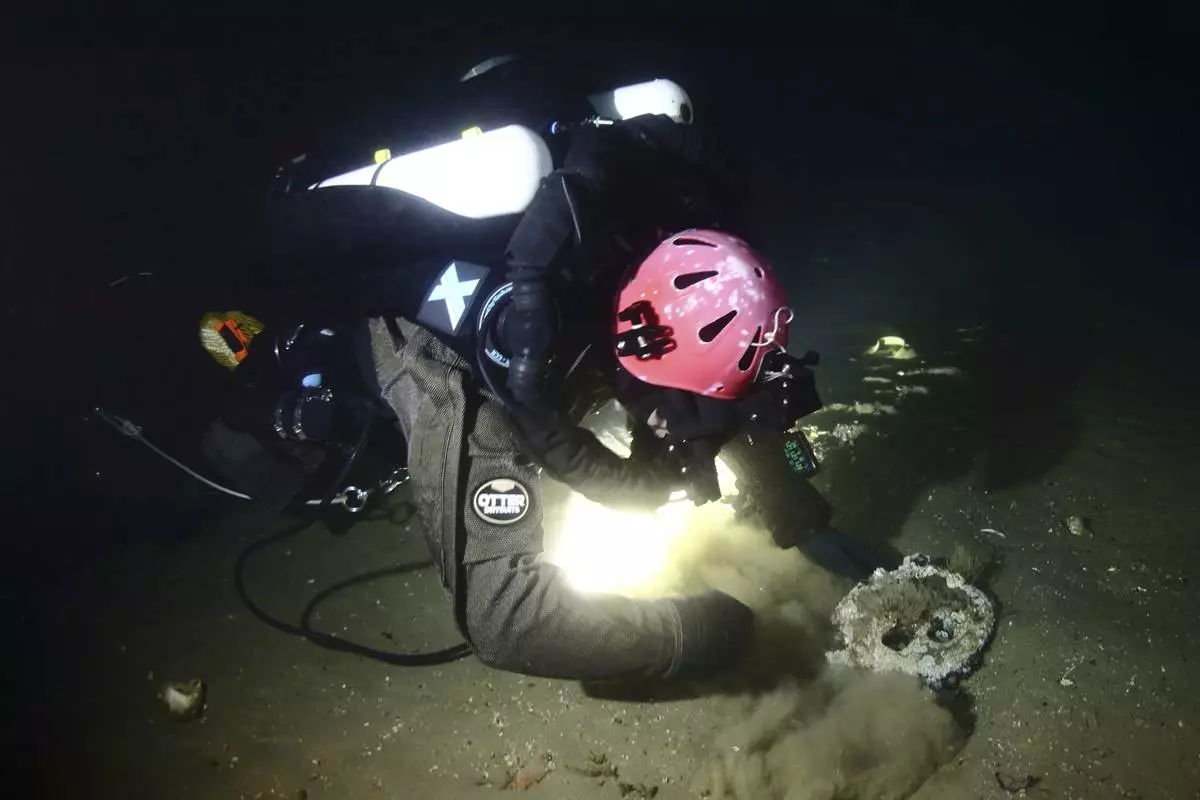PORTLAND, Maine (AP) — The French steamship Le Lyonnais, a marvel for its time, was feared lost forever when a maritime disaster in 1856 sent her to the bottom of the ocean off Massachusetts.
Generations later, a marine salvage crew is ready to write the next chapter in the history of the passenger liner, which was built as the Age of Sail was yielding to steamships. New Jersey marine salvage firm Atlantic Wreck Salvage found the wreck of Le Lyonnais about 200 miles (off New Bedford, Massachusetts, in late August.
The discovery of the steamship follows years of work to locate it, but it also represents a new beginning, said Jennifer Sellitti, a spokesperson for Atlantic Wreck Salvage and a crew member on D/V Tenacious, the vessel the company uses for dives and salvages. The next steps are to document the wreck site, map it and determine what artifacts can be brought to the surface, Sellitti said.
“Finding it in some ways is closure, in some ways is the end. In some ways it's the beginning — documenting it, determining what is down there and what should be brought up,” Sellitti said. “This was a very early example of a steam engine.”
Le Lyonnais was about 260 feet (79 meters) in length and tasked with carrying passengers and cargo between New York and France, Sellitti said. The ship had sails but was also outfitted with a horizontal steam engine and an iron hull, making her an example of the way innovation was changing shipping in the mid-19th century.
But disaster struck during the ship's first return voyage back to the French city of Le Havre from the U.S. The ship collided with the Maine-built barque Adriatic, which was en route from Belfast, Maine, to Savannah, Georgia, according to Atlantic Wreck Salvage's research, which Sellitti is using as the basis for a book on the ship called “The Adriatic Affair.”
The collision left Le Lyonnais bearing a hole in the hull that would eventually sink the boat. Of the 132 passengers and crew, 114 died. The Adriatic made it back to New England for repairs.
The salvage crew was able to find Le Lyonnais by doing historical research and using sonar to narrow down the site of its final resting place. The ship is likely too deteriorated to be raised, Sellitti said.
However, the historic nature of the ship makes its discovery significant, said Eric Takajian, a member of the crew that found the ship.
“Being one of the first French passenger steamships to have a regularly scheduled run crossing the Atlantic and an early transitional steamship make Le Lyonnais’ discovery significant,” he said.

In this undated photo provided by Atlantic Wreck Salvage, Joe Mazraani, Eric Takakjian and Tom Packer review footage between dives on the passenger steamship Le Lyonnais, Saturday, Aug. 24, 2024, off the coast of Massachusetts. (Photo by Atlantic Wreck Salvage, via AP)

In this undated photo provided by Atlantic Wreck Salvage, members the Discovery team pose in New Bedford, Mass., on Sunday, Aug. 25, 2024. with portholes recovered from the passenger steamship Le Lyonnais. (Atlantic Wreck Salvage via AP)

Discovery team member Joe Mazraani fans away the sand to reveal a deadeye used as part of the sail rigging on the passenger steamship Le Lyonnais, during a dive on the wreck, Saturday, Aug. 24, 2024, off the coast of Massachusetts. (Andrew Donn/Atlantic Wreck Salvage via AP)
NEW YORK (AP) — In what appears to be a sophisticated, remote attack, pagers used by hundreds of members of Hezbollah exploded almost simultaneously in Lebanon and Syria Tuesday, killing at least nine people — including an 8-year-old girl — and wounding thousands more.
The Iran-backed militant group blamed Israel for the deadly explosions, which targeted an extraordinary breadth of people and showed signs of being a long-planned operation. How the attack was executed is largely uncertain and investigators have not immediately said how the pagers were detonated. The Israeli military has declined to comment.
Here's what we know so far.
Hezbollah leader Hassan Nasrallah previously warned the group’s members not to carry cellphones, saying they could be used by Israel to track the group's movements. As a result, the organization uses pagers to communicate.
A Hezbollah official told The Associated Press the exploded devices were from a new brand the group had not used before. The official, who spoke on condition of anonymity because he was not authorized to talk to the press, did not identify the brand name or supplier.
Nicholas Reese, adjunct instructor at the Center for Global Affairs in New York University’s School of Professional Studies, explains smart phones carry a higher risk for intercepted communications in contrast to the more simple technology of pagers.
This type of attack will also force Hezbollah to change their communication strategies, said Reese, who previously worked as an intelligence officer, adding that survivors of Tuesday's explosions are likely to throw away "not just their pagers, but their phones, and leaving their tablets or any other electronic devices.”
With little disclosed from investigators so far, multiple theories have emerged Tuesday around how the attack might have been carried out. Several experts who spoke with The Associated Press suggest that the explosions were most likely the result of supply-chain interference.
Very small explosive devices may have been built into the pagers prior to their delivery to Hezbollah, and then all remotely triggered simultaneously, possibly with a radio signal.
By the time of the attack, “the battery was probably half-explosive and half-actual battery," said Carlos Perez, director of security intelligence at TrustedSec.
A former British Army bomb disposal officer explained that an explosive device has five main components: A container, a battery, a triggering device, a detonator and an explosive charge.
“A pager has three of those already,” explained the ex-officer, who spoke on condition of anonymity because he now works as a consultant with clients on the Middle East. “You would only need to add the detonator and the charge.”
After security camera footage appeared on social media Tuesday purporting to show one of the pagers explode on a man’s hip in a Lebanese market, two munitions experts also said that the blast appeared to be the result of a tiny explosive device.
“Looking at the video, the size of the detonation is similar to that caused by an electric detonator alone or one that incorporates an extremely small, high-explosive charge,” said Sean Moorhouse, a former British Army officer and explosive ordinance disposal expert.
This signals involvement of a state actor, Moorhouse said. He adds that Israel’s foreign intelligence agency, the Mossad, is the most obvious suspect to have the resources to carry out such an attack.
N.R. Jenzen-Jones, an expert in military arms who is director of the Australian-based Armament Research Services, agreed that the scale and sophistication of the attack “almost certainly points to a state actor,” and that Israel had been accused of carrying out such operations in the past. Last year, AP reported that Iran accused Israel of trying to sabotage its ballistic missile program through faulty foreign parts that could explode, damaging or destroying the weapons before they could be used.
It would take a long time to plan an attack of this scale. The exact specifics are still unknown, but experts who spoke with the AP shared estimates ranging anywhere between several months to two years.
The sophistication of the attack suggests that whoever is behind it has been collecting intelligence for a long time, Reese explained. An attack of this caliber requires building the relationships needed to gain physical access to the pagers before they were sold; developing the technology that would be embedded in the devices; and developing sources who can confirm that the targets were carrying the pagers.
And it's likely the compromised pagers seemed normal to their users for some time before the attack. Elijah J. Magnier, a Brussels-based veteran and a senior political risk analyst with over 37 years experience in the region, said he has had conversations with members of Hezbollah and survivors of Tuesday's pager attack. He said the pagers were procured more than six months ago.
“The pagers functioned perfectly for six months," Magnier said. What triggered the explosion, he said, appeared to be an error message sent to all the devices.
Based on his conversations with Hezbollah members, Magnier also said that many pagers didn’t go off, allowing the group to inspect them. They came to the conclusion that between 3 to 5 grams of a highly explosive material were concealed or embedded in the circuitry, he said.
Another possibility is that malware could have been inserted into the operating system of the pagers — somehow causing the device batteries to all overload at a specific time, causing them to burst into flame.
According to a Hezbollah official and Lebanese security officials, the pagers first heated up and then exploded in the pockets, or the hands, of those carrying them Tuesday afternoon.
These pagers run on lithium ion batteries, the Hezboolah official said, claiming the devices exploded as the result of being targeted from an Israeli “security operation," without elaborating further.
When overheated, lithium ion batteries can smoke, melt and even catch on fire. Rechargeable lithium batteries are used in consumer products ranging from cellphones and laptops to electric cars. Lithium battery fires can burn up to 590 C (1,100 F).
Still, Moorhouse and others noted that images and video footage seen Tuesday more strongly resembled the detonation of small explosive charge, not an overheating battery.
“A lithium ion battery fire is one thing, but I’ve never seen one explode like that. It looks like a small explosive charge,” said Alex Plitsas, a non-resident fellow at the Atlantic Council who leads their initiative studying the future of global terrorism threats and counter-terrorism efforts.
Among those pointing to the likelihood of a supply chain attack is Jenzen-Jones, who adds that “such a large-scale operation also raises questions of targeting" — stressing the number of causalities and enormous impact reported so far.
“How can the party initiating the explosive be sure that a target’s child, for example, is not playing with the pager at the time it functions?” he said.

People donate blood for those who were injured by their exploded handheld pagers, at a Red Cross center, in the southern port city of Sidon, Lebanon, Tuesday, Sept. 17, 2024. (AP Photo/Mohammed Zaatari)













